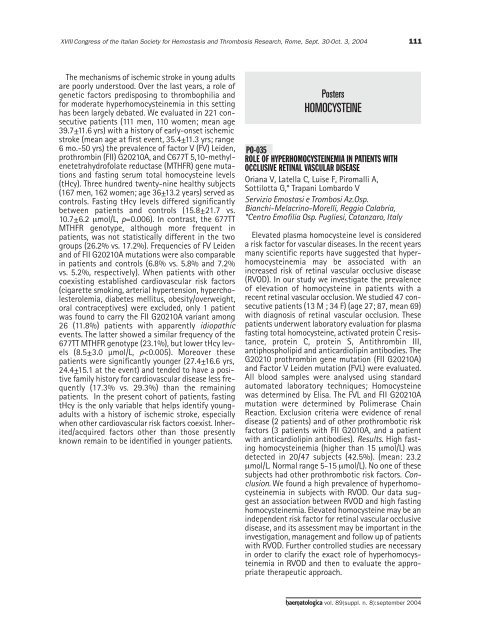XVIII Congress of the Italian Society for Hemostasis and Thrombosis Research, Rome, Sept. 30-Oct. 3, <strong>2004</strong>111The mechanisms of ischemic stroke in young adultsare poorly understood. Over the last years, a role ofgenetic factors predisposing to thrombophilia andfor moderate hyperhomocysteinemia in this settinghas been largely debated. We evaluated in 221 consecutivepatients (111 men, 110 women; mean age39.7±11.6 yrs) with a history of early-onset ischemicstroke (mean age at first event, 35.4±11.3 yrs; range6 mo.-50 yrs) the prevalence of factor V (FV) Leiden,prothrombin (FII) G20210A, and C677T 5,10-methylenetetrahydrofolatereductase (MTHFR) gene mutationsand fasting serum total homocysteine levels(tHcy). Three hundred twenty-nine healthy subjects(167 men, 162 women; age 36±13.2 years) served ascontrols. Fasting tHcy levels differed significantlybetween patients and controls (15.8±21.7 vs.10.7±6.2 µmol/L, p=0.006). In contrast, the 677TTMTHFR ge<strong>no</strong>type, although more frequent inpatients, was <strong>no</strong>t statistically different in the twogroups (26.2% vs. 17.2%). Frequencies of FV Leidenand of FII G20210A mutations were also comparablein patients and controls (6.8% vs. 5.8% and 7.2%vs. 5.2%, respectively). When patients with othercoexisting established cardiovascular risk factors(cigarette smoking, arterial hypertension, hypercholesterolemia,diabetes mellitus, obesity/overweight,oral contraceptives) were excluded, only 1 patientwas found to carry the FII G20210A variant among26 (11.8%) patients with apparently idiopathicevents. The latter showed a similar frequency of the677TT MTHFR ge<strong>no</strong>type (23.1%), but lower tHcy levels(8.5±3.0 µmol/L, p
112PostersPO-036CATASTROPHIC VASCULAR OCCLUSION SYNDROME IN APATIENT WITH MILD HYPERHOMOCYSTEINEMIA ANDABDOMINAL AORTIC ANEURYSMBenevolo G, Vendramin C, Fra GP, Gaida<strong>no</strong> GUDA Ematologia & Clinica Medica Generale,Dipartimento Scienze Mediche, Università delPiemonte Orientale "Amedeo Avogadro", AziendaMaggiore della Carità, Novara, ItalyHyperhomocysteinemia is a recognised risk factorfor ve<strong>no</strong>us thromboembolism and is associated withan increased risk of occlusive arterial disease. Highplasma levels of total homocysteine result from theinteraction between genetic and acquired determinants;moreover, some authors have reported a relationshipbetween hyperhomocysteinemia andabdominal aortic aneurysm (AAA). We report thecase of a 69-year old man who was diag<strong>no</strong>sed ashaving mild hyperhomocysteinemia (17.4 mmol/L)with heterozygous 677C→T substitution in MTHFRgene and AAA (4.2 cm) with thrombi four monthsbefore his current admission to our Division. Thepatient was being treated with oral anticoagulantstherapy (OAT) for wandering phlebitis and with vitaminsfor hyperhomocysteinemia. On admission, hepresented with sudden chest pain, dyspnea and feverwith elevated D-dimer levels, <strong>no</strong>rmal levels of homocysteineand INR 2.76 (target 2.5). A lung perfusionscan revealed pulmonary embolism whereas a colordopplerultraso<strong>no</strong>graphy resulted negative for deepvein thrombosis. Thrombophilic screening showedabsence of antiphospholipid antibodies and <strong>no</strong>rmalityof AT, PC and PS levels. FV Leiden and ab<strong>no</strong>rmalprothrombin were absent. OAT was replaced by subcutaneouslow-molecular-weight heparin (LMWH)with rapid improvement of lung perfusion and thepatient was discharged with OAT (INR target 3.00).During subsequent OAT, at day 21 after discharge, thepatient developed a femoral vein thrombosis despitean INR=2.90 and homocysteine=8.9 umol/L. On newadmission, he was managed with unfractionatedheparin (UFH) followed by LMWH. After three dayshe developed an extensive stroke with hemiparesis.The clinical course was complicated by peripheralarterial ischemia treated with embolectomy. Despiteheparin therapy, the patient died after developingcoma. Blood cell counts remained <strong>no</strong>rmal throughoutthe clinical course. An autopsy with histologicalexamination did <strong>no</strong>t reveal occult cancer disease butshowed a widespread ve<strong>no</strong>us and arterial thromboticocclusion. In patients with AAA, the use of <strong>supplement</strong>alvitamins aimed at lowering plasma homocysteinemay <strong>no</strong>t be sufficient to modify vasculardisease progression.PO-037HOMOCYSTEINEMIA AS RISK FACTOR FOR CARDIO-EMBOLICSTROKE IN PATIENTS WITH NONVALVULAR ATRIALFIBRILLATIONLoffredo L, * D'Angelo A, **Fimognari FL,Cangemi R,* Sampietro F, * Mazzola G, Di Lecce VN,Buttiglieri R, Violi FUniversity "La Sapienza", Rome, Italy, *Servizio diCoagulazione ed Unita’ Ricerca Trombosi, ScientificInstitute H.S. Raffaele, Milan, Italy, **U.O.C. MedicinaInterna, Ospedale L. Parodi-Delfi<strong>no</strong>, ASL RM G,Colleferro, ItalyAtrial fibrillation (AF) is complicated by a high rateof ischemic stroke. Previous studies have shown thatincreased circulating total homocysteine (tHcy) is anindependent predictor of stroke, but it is unclearwhether it does predict stroke also in patients withatrial fibrillation. The objective of this study was toevaluate if increased tHcy is an independent predictorof cardio-embolic stroke in patients with <strong>no</strong>nvalvularAF. We studied 163 consecutive patients (77males and 86 females; mean age 72.3±8.8 years)with chronic (n=118) or paroxysmal (n=45) AF of<strong>no</strong>nvalvular origin. Among them, ischemic stroke wasdocumented by MNR or CT imaging in 40 patients(16 males and 24 females mean age 74.8±8.8 years).Fasting tHcy levels were determined by HPLC aftercleavage and reduction with sodium borohydride followedby derivatization with SBD-F (ammonium-7-fluorobenzo-2-oxa-1,3-diazole-4-sulfonate). Multivariateanalysis showed that age (OR:1.063 for each1 year increase of age; 95% C.I.: 1.009-1.121,p=0.034), total homocysteine (OR:1.052; for each 1µmol/l increase, 95% C.I.: 1.005-1.102; p=0.025) andfibri<strong>no</strong>gen (OR:1.008 for each 1 mg/dL increase; 95%C.I.: 1.002-1.013; p=0.009) were independent predictorsof ischemic stroke. In patients with <strong>no</strong>nvalvularatrial fibrillation, increased fasting tHcy levelsare an independent predictor of cardio-embolicstroke, suggesting that changes in methioninemetabolism may predispose to thromboembolism inthis setting.PO-038C677T AND A1298C MTHFR, A2756G MTR AND 844INS68CBS GENE POLYMORPHISMS IN ATRIAL FIBRILLATIONGiusti B, Poli D,° Gensini F, # Sestini I, Poggi F,Rossi L, Lapini I, Lucarini L, Giuello A, Pepe G,Abbate R, Gensini GFDepartment of Medical and Surgical Critical Area,University of Florence; °Dipartimento Cardiologico edei Vasi, Azienda Ospedaliera Careggi, Florence;#Department of Clinical Pathophysiology, Universityof Florence, Italyhaematologica vol. <strong>89</strong>(suppl. n. 8):september <strong>2004</strong>
















